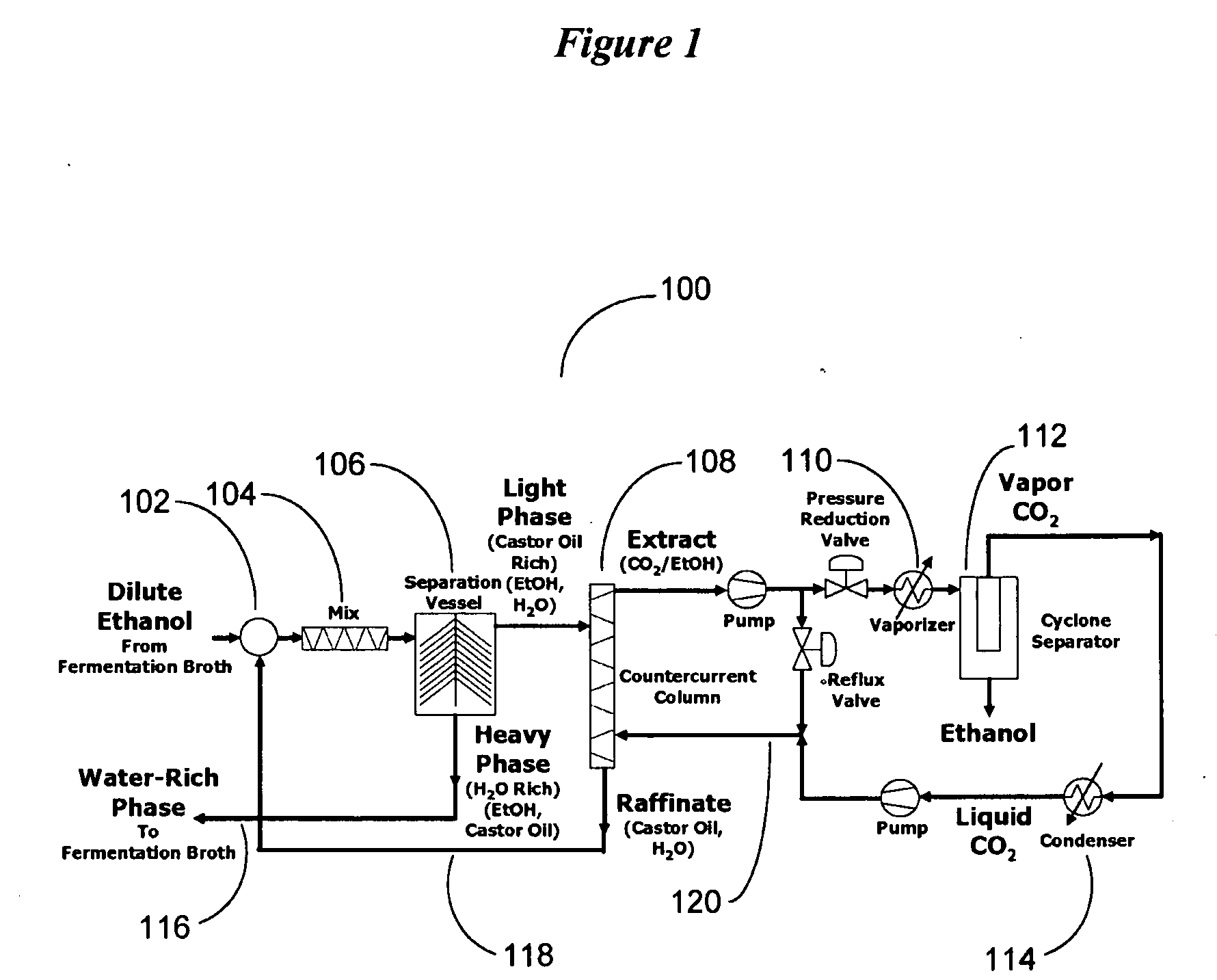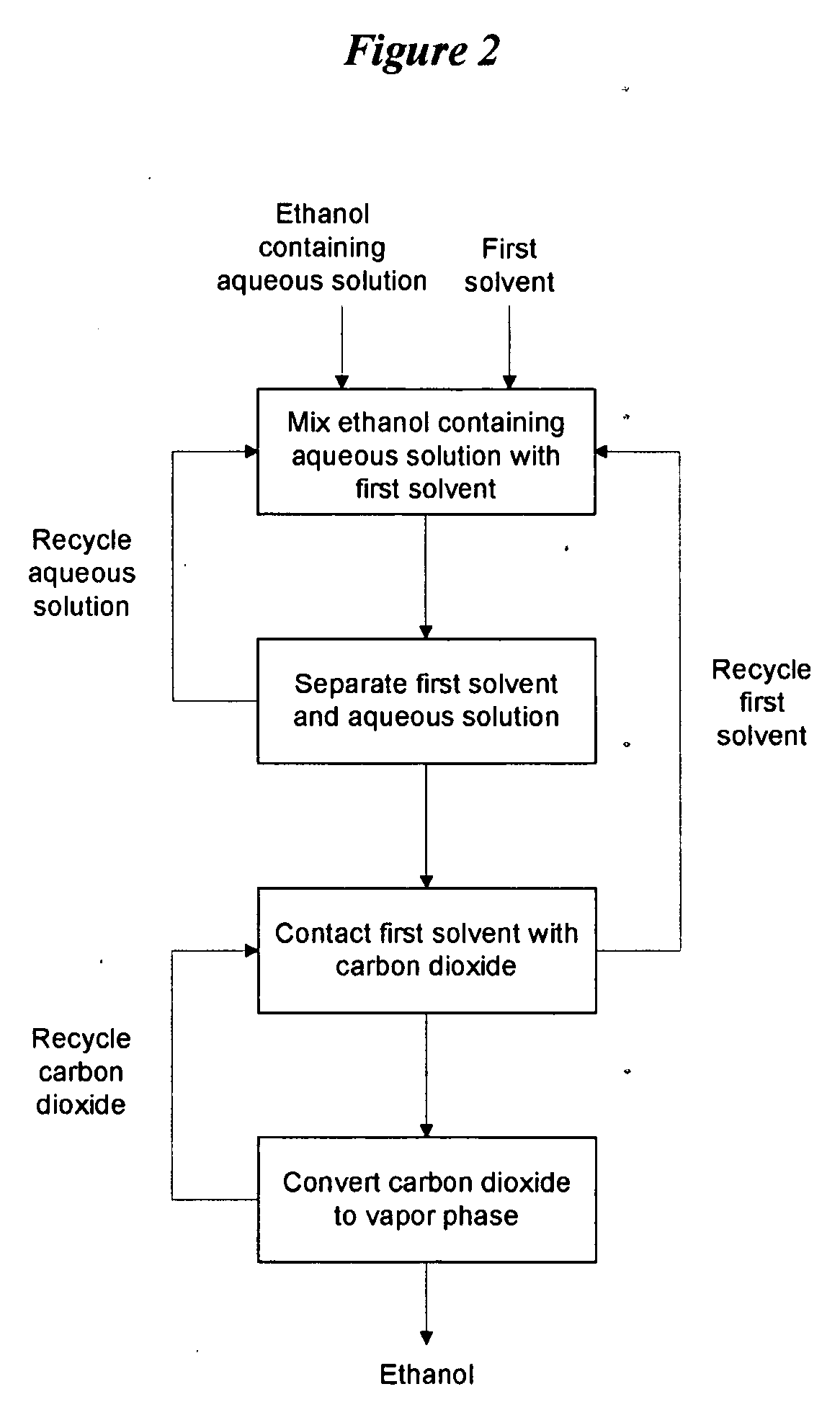Energy Efficient Separation of Ethanol From Aqueous Solution
a technology of ethanol and aqueous solution, applied in the direction of separation process, bulk chemical production, lighting and heating apparatus, etc., can solve the problems of energy and economic inefficiency, less effective water rejection effect of solvent, etc., to prevent resource waste, reduce energy consumption, and reduce the consumption of raw materials
- Summary
- Abstract
- Description
- Claims
- Application Information
AI Technical Summary
Benefits of technology
Problems solved by technology
Method used
Image
Examples
example 1
Extraction of Ethanol from An Ethanol-Water Solution
[0105]The exemplified process describes the adsorption of ethanol into castor oil and the subsequent extraction of the ethanol from the castor oil with near-critical carbon dioxide.
[0106]Referring to FIG. 1, a dilute ethanol-water solution from a fermination broth is combined with the recycled water from the first stage separator (centrifuge) and the castor oil saturated with water. The ethanol-water solution would nominally be in the range of 3 to 8 wt % ethanol in water. The recycled water will retain ethanol and some castor oil. The stream of ethanol water and castor oil is well-mixed and then subsequently separated into a light phase and heavy phase. While a settling tank separator could be employed, process economics favor the use of a centrifuge to accelerate the phase separation. The heavy phase is primarily water with some remaining ethanol and an inevitable contamination of castor oil.
[0107]The heavy phase is returned to t...
example 2
Extraction of Ethanol from An Ethanol-Water Solution
[0110]A 10 kg of 50 wt % ethanol / water solution was combined with 20 kg of neat castor oil. The feed material had 5 kg ethanol combined with 5 kg water. A two stage counter countercurrent extraction was employed, thus creating a castor oil / ethanol solution with 3.795 kg of ethanol and the water-rich solution had 1.205 kg of ethanol. The resultant phases were separated with a centrifuge. The castor oil rich extract was 16.5% ethanol and the water-rich raffinate was 19.42% ethanol. The castor oil / ethanol solution was subject to subsequent extraction by carbon dioxide.
[0111]The second stage of extraction used a countercurrent column to extract the ethanol from castor oil with liquid CO2. The liquid CO2 was at 95 bar and 22° C. with a density of 0.836 kg / L. At this density, CO2 is less dense than the castor oil. Castor oil was injected into a countercurrent column near the upper elevation of the countercurrent column. CO2 was introduce...
PUM
| Property | Measurement | Unit |
|---|---|---|
| v/v | aaaaa | aaaaa |
| temperatures | aaaaa | aaaaa |
| boiling point | aaaaa | aaaaa |
Abstract
Description
Claims
Application Information
 Login to View More
Login to View More - R&D
- Intellectual Property
- Life Sciences
- Materials
- Tech Scout
- Unparalleled Data Quality
- Higher Quality Content
- 60% Fewer Hallucinations
Browse by: Latest US Patents, China's latest patents, Technical Efficacy Thesaurus, Application Domain, Technology Topic, Popular Technical Reports.
© 2025 PatSnap. All rights reserved.Legal|Privacy policy|Modern Slavery Act Transparency Statement|Sitemap|About US| Contact US: help@patsnap.com



